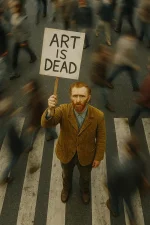
Image taken from https://sora.com/g/gen_01jqh4cbmcewwbbr5f5b6keb49
The question might sound hyperbolic, but the rapid rise of artificial intelligence in creative domains has prompted spirited debates about the future of human-driven artistry. AI models like ChatGPT have expanded their reach into generating not only text but also images, illustrations, and even theatrical narratives—raising fundamental questions about originality, copyright, and the value of human craftsmanship. As these powerful tools gain traction, some fear that traditional artistic methods may be overshadowed, if not entirely replaced.
The AI Art Boom and Its Critics
One highly publicized case embodies the current tensions in the art world. The Spanish television program La revuelta posted 19 AI-generated illustrations on Instagram, mimicking the instantly recognizable style of Studio Ghibli. Though the post garnered over 51,000 likes, it also sparked a backlash from critics who believed that a human artist should have been commissioned. This criticism is emblematic of broader concerns that automated processes are undermining the hard-earned expertise of artists, potentially devaluing their livelihood and creative authenticity.Notably, Studio Ghibli co-founder Hayao Miyazaki has been vocally critical of AI-generated art. This opposition highlights the controversial practice of training AI on copyrighted material—often scraped from the internet—without explicit consent from original creators. Legal experts question whether AI models using these creative works in their training datasets constitute fair use or an infringement of intellectual property rights.
Beyond the Canvas: AI in Theater and Literature
AI’s encroachment into creative fields extends to live performance and writing. In the play McNeal, featuring actor Robert Downey Jr., ChatGPT is used directly to comment on how artificial intelligence shapes human creativity. Playwright Ayad Akhtar has openly acknowledged that he relied on AI tools for some of his writing, fanning discussions about whether algorithmic assistance might dilute an author’s unique voice or artistry over time.Critics argue that business imperatives—cutting costs and automating tasks—often drive AI adoption in creative industries. This approach could diminish the value of human creativity and tacitly endorse a future where the spark of imagination is outsourced to machines. As AI tools become more integrated, concerns escalate over the erosion of human ingenuity and the unique perspectives artists bring to their work.
The Double-Edged Sword of AI Assistance
Empirical research provides a nuanced outlook. Some studies suggest that AI can temporarily augment human creative performance by offering fresh, unexpected ideas. In practice, an AI prompt might help an illustrator step outside their comfort zone or push a writer to experiment with unfamiliar genres. Yet these same studies caution that when AI support is removed, creative output can drop—indicating a dependency that may stifle true innovation in the long run.Moreover, AI’s reliance on pattern recognition can, paradoxically, lead to creative homogenization. Because these models identify and reproduce common stylistic elements, they can amplify mainstream aesthetics at the expense of more avant-garde or nonconformist expressions. Over time, this dynamic risks creating an echo chamber in which certain styles become formulaic, thereby limiting genuine artistic breakthroughs.
Charting a Path Forward
The growing influence of AI in art, literature, and design poses a dilemma: how do we seize the benefits of cutting-edge technology without relegating human imagination to the sidelines?- Transparent Attribution
Creators and institutions could disclose the extent to which AI tools shaped a piece of work. Such transparency not only respects the audience but also clarifies the line between human and machine-driven contributions. - Ethical Training Protocols
Formal guidelines on how AI models are trained—including copyrights and permissions—could help ensure that artists are properly compensated or credited for the data derived from their work. - Hybrid Collaboration
AI can excel at generating ideas and prototypes, but humans should retain ultimate creative control. By working in tandem, it’s possible to blend computational efficiency with human emotional depth. - Continuing Empirical Inquiry
More systematic research is needed to understand the long-term impact of AI on human creativity. Insights from such studies can inform policy, educational curricula, and ethical frameworks.
Conclusion
While headlines may proclaim that the future of art belongs to the machines, reality is far more layered. AI’s capabilities unquestionably offer fresh avenues for exploration, from generating new visual styles to assisting with intricate storytelling. Yet the singular depth and variety of human creativity—shaped by emotion, cultural context, and lived experience—remain indispensable.So, is art already dead? Hardly. But as AI blurs the boundaries between the artist and the algorithm, it raises essential questions about how we define and protect the essence of creativity. In this evolving landscape, the choices made by artists, policymakers, and audiences will determine whether AI remains a valuable tool in the human creative toolkit—or becomes an existential threat to the craft itself.